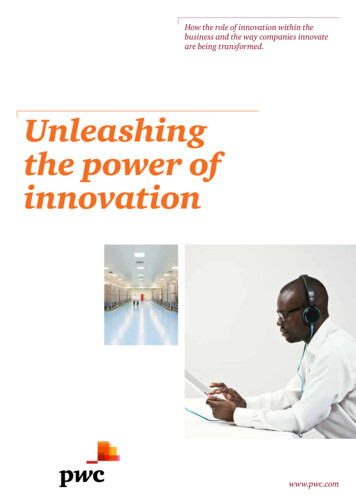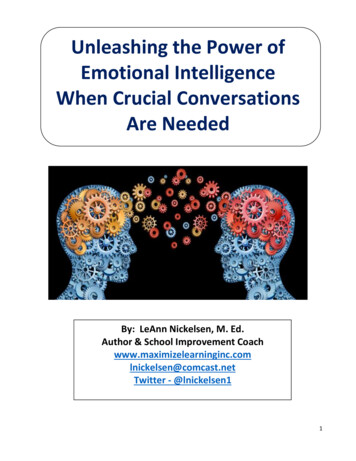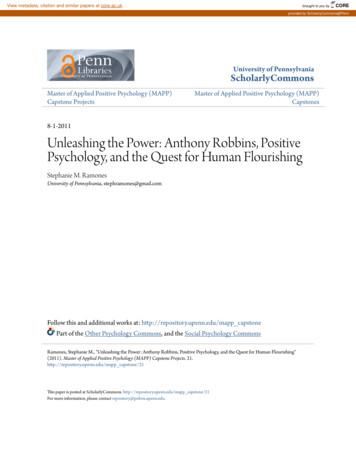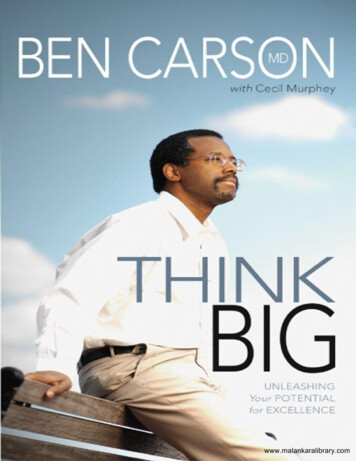
Transcription
How the role of innovation within thebusiness and the way companies innovateare being transformed.Unleashingthe power ofinnovationwww.pwc.com
Gaugingchangingperspectives2Unleashing the power of innovation
246We surveyed 246 CEOs from aroundthe worldUnleashing the powerof innovation.Drawing on a survey of 246 CEOsfrom around the world, the reportexplores the changing role and natureof innovation in today’s businesses1. Tosee how innovation is evolving, we’vecompared the findings to a similarstudy we carried out in 20092.What emerges from the latest surveyis that CEOs are now taking personalresponsibility for directing andinspiring innovation as it becomesan ever more vital element ofbusiness survival and success. Howcompanies innovate is also beingtransformed. Companies might oncehave been satisfied with incrementalproduct improvements. Now, they’reincreasingly looking for breakthroughdevelopments in their businessmodels and the solutions they providefor customers.The problem is that while the eyes ofthe CEO are fixed on innovation, thebody of the organisation may not befollowing. The ‘antibodies’ that inhibitinnovation include a culture that seesit as separate from the mainstreamoperations of the business and is slowto commercialise new ideas.The days when innovation was thepreserve of research and development(R&D) units at the sidelines of thebusiness have gone. Successfulcompanies recognise that innovationis a mainstream process, which bringstogether frontline teams, customersand a range of different partners frombeyond the organisation. At the heartof these developments is the realisationthat how you innovate determineswhat innovations you deliver.We hope that you find this reportuseful and interesting. If you’d like todiscuss any of the issues raised andhow to address them in more detailplease feel free to contact your usualPwC representative or one of theauthors listed on page 13.1 he primary research includes the views of 246 CEOs from PwC’s Global CEO panel, who were polled in May 2013. PwC’s panel is made up of a crossTsection of multinational companies across all sectors, company sizes and home locations (both from developed and emerging economies).2Caught in the crossfire: ation.jhtmlPwC3
“ Innovation is a prerequisite for survival I make sure my management team hasthe right attitude towards change andchallenges the norm.”CEO, Western EuropeIncreasing appetitefor innovationInnovation is moving up theboardroom agenda as companiesrecognise its vital importance insustaining growth.Almost all the CEOs taking part inour survey recognise the value ofinnovation for their companies, withmost seeing it as either a priority ora primary focus (see Figure 1). Thisis a step change from our surveyin 2009. Back then, sharpeningoperational effectiveness was theoverriding objective as companiessought to survive the sudden lossof revenue caused by the financialcrisis. Now, three-quarters of CEOsregard innovation as at least equallyimportant to operational effectiveness(see Figure 2). The strategicimportance of innovation is furtherreflected in the fact that CEOs see theirrole as leader or visionary rather thandelegating responsibility down the line(see Figure 3).Innovation’s rise up the CEO agendareflects the changing businessenvironment. Growth is nowexceptionally hard won and simplydoing what you’re doing a littlebetter may not be enough to sustainit. The competitive climate has alsobeen transformed as the internet,social media and new digital devices,revolutionise the way consumers buyproducts and services and what theyexpect from them.64%64% say innovation and operationaleffectiveness are equally important to thesuccess of my company.4Unleashing the power of innovation
Figure 1Figure 2Which of the following statements best describes yourcompany’s appetite for innovation?Which is more important to the success of your company –operational effectiveness or innovation?3%2%Innovation is not a priorityfor us in the markets inwhich we operate.10%Innovation is our primaryfocus. We are creativeand regularly pioneercutting edge ideas andapproaches.Operational effectivenessis far more important to thesuccess of my company thaninnovation.3%Innovation is far moreimportant to the successof my company thanoperational effectiveness.Innovation ismore importantto the successof my companythan ssis moreimportant tothe successof mycompanythaninnovation.0%Unsure/Don’t know51%36%We value innovation. We’regood at recognising newideas and approaches andadopting them quickly.Base: All respondents (246)Source: Global CEO Pulse Survey on Innovation8%64%Innovation is one of ourpriorities. We are goodat generating new ideasand approaches.Base: All respondents (246)Source: Global CEO Pulse Survey on InnovationInnovation andoperationaleffectiveness areequally important tothe success of mycompany.Figure 3Which of the following do you see as your primary role in driving innovation within your Sponsor5%Advocate1%FollowerBase: All respondents (246)Source: Global CEO Pulse Survey on InnovationPwC5
“ I believe that innovation is delivering value indifferent forms. What really changes is how youdeliver that value to the customers, and how youextract that information from them.”CEO, Latin AmericaInnovation becomesmore radicalThe focus of innovation is becomingmore radical as CEOs look for wholenew sources of revenue rather than justbetter products.The changing business landscape isreflected in the evolving nature ofinnovation. Products are still the toppriority. But as Figure 4 highlights,business models and customerexperience are close behind.6Unleashing the power of innovationWhile in the past R&D units wouldhave focused on ways to enhance theproduct range, many CEOs are lookingto go much further by transformingwhat they sell and how they sell it. Asoap powder manufacturer might openup a chain of launderettes or an enginemaker could move from selling enginesto charging users for running them,for example. What brings these newbusiness models together is a shift infocus from products to solutions. Theproduct is clearly an important partof the solution, but not everything.In turn, the role of technology goesbeyond creating new and improvedproducts towards gaining sharperinsights into what customers want andhow to deliver it. A common threadin the feedback from participants wasthe need ‘to spend more time in themarketplace’.
Figure 4In which of the following areas is your company looking to innovate over the next 3 years?First choiceTop 3 mentions26%Products48% Products17%Business model45% Technology15%Customer experience44% Customer experience13%Technology43% Systems and processes9%Supply chain and channels to market41% Business model9%Services37% Services8%Systems and processes33% Supply chain and channels to market2%None/Don’t know2% None/Don’t know0%Other2% OtherBase: All respondents .000000Source: GlobalCEO PulseSurvey16.666667on Innovation01020304050“ Innovation is a part of the overall business process inbringing better operational efficiencies to our clients”CEO, North AmericaPwC7
“ T he key ingredient is creating anorganisational culture that encouragesinnovation in all areas.”CEO, Central EuropeThe key ingredientsfor innovationAs what CEOs expect from innovationchanges, so is the way it’s beingdelivered and the desired culture thatsurrounds this.The importance of putting innovationat the heart of strategic managementand involving the frontline of thebusiness is reflected in the fact thatCEOs see the right leadership andculture as the most crucial ingredientsfor success (see Figure 5). Relatedareas of culture such as the capacity forcreativity, willingness to collaborateand readiness to challenge acceptednorms are also high on the list.A clear indication of innovation’smove into the mainstream is thatmany companies now expect staff toallocate at least some of their timeto developing and supporting newideas, rather than simply relying on afew bright sparks. Many participantstalked about the need ‘to empowerfrontline staff’. The fact that talent isquite low down the list would furtherunderline the move from innovationbeing ‘alchemy’ by the few to ‘cookery’by the many.8Unleashing the power of innovationThe importance of collaboration canbe seen in the number of companiesthat are now working with customersor other businesses to co-create newproducts and solutions. The rapidupsurge in the sale of e-readersand e-books is a good example ofhow these collaborations can creategame changing opportunities forsome businesses and the threatof marginalisation for slowermoving competitors.
Figure 5What do you think are the most important ingredients for successful innovation at a company?First choiceTop 3 mentions26%Strong visionary business leadership57%Having the right culture to foster and support innovation26%Having the right culture to foster and support innovation44%Strong visionary business leadership9%The willingness to challenge organisational norms and take risks37%The willingness to challenge organisational norms and take risks9%Collaborating with customers31%The ability to capture ideas throughout the organisation9%Having a capacity and capability for creativity31%Having a capacity and capability for creativity9%The ability to capture ideas throughout the organisation30%Collaborating with customers5%Being able to locate and train the right people26%Being able to locate and train the right people2%Collaborating with suppliers11%Use of new techn (such as social media) to support innovation1%Being able to secure the right levels of funding11%Collaborating with suppliers1%Use of new tech (such as social media) to support innovation9%Being able to secure the right levels of funding4%None/Don’t know4%None/Don’t knowBase: All respondents (246)Source: Global CEO Pulse Survey on Innovation26%26% of CEOs said strong visionary businessleadership was the most important ingredient tosuccessful innovation at a companyPwC9
Overcoming thebarriers to innovationOvercoming the barriers to innovationis likely to require new ways of buildingit into the strategic and operationalmanagement of the business.The survey highlights a number ofbarriers to innovation (see Figure6). The strain on limited financialresources heads the list of constraints,though interestingly funding wasn’tin itself seen as a key ingredient forinnovation. This suggests that moneycan’t buy you success on its own, butit does still need to be managed in asmart way. This is especially so at atime when the focus is shifting fromgradual to more radical innovation.While the potential rewards fromnew breakthroughs are higher thanincremental developments, the chancesof success are lower and thereforehow to target funding where it canearn its best return is more difficult.One of the keys to addressing thischallenge is making sure your appetitefor innovation matches your overalltargets for growth. For most maturecompanies this is likely to mean abalance between low risk/returnproduct development and higherreturn but less certain breakthroughinnovation. While the actual balancewill vary, it’s possible to gauge the rightapproach for your company and trackprogress through metrics such as thevitality index.10Unleashing the power of innovationCEOs also see culture as one of thebiggest constraints. This suggeststhat encouraging people within theorganisation to embrace innovationis still proving to be a challenge. Animportant part of overcoming thisbarrier is to eliminate the bureaucraticdecision making processes thatslow down the commercialisation ofinnovations. A participant went sofar as calling for the ‘managementpyramid to be turned on its head’,while accepting that in reality shewould have to ‘struggle with theexisting culture and structure, likemost companies.’Building innovation into everyone’sjob description and creatingopportunities for collaborationthat go beyond the traditionalfunctional and organisationalboundaries are also important. Themost successful companies havegone further in seeking to create aculture of innovation. In keeping withinnovation’s changing risk/rewardprofile this includes giving peopleextra time to create and nurtureopportunities and being prepared totolerate risk and failure.
“ Give employees specific time periods towork on something outside of their jobdescription and with other teams to fostercross fertilisation of ideas.”CEO, Asia PacificFigure 6Which of the following constraints is stopping you from being more innovative?43% Financial resources41% Existing organisation culture30% Lack of talent21% Political and reulatory factors18% Inadequate technology14% Nothing is stopping me from being innovative9% Weak governance/leadershipBase: All respondents (246)Source: Global CEO Pulse Survey on Innovation43%43% of CEOs said financial resources were one ofthe biggest constraints on being more innovativePwC11
Is your organisationcreating full valuefrom innovation?Innovative organisations are marked out by theirvisionary leadership, licence to explore new ideas,readiness to collaborate and ability to commercialisenew ideas quickly.We believe that there are five key questions yourorganisation will need to address if it is to becomegenuinely innovative and generate full value fromits investment:12345Does the wayyou rengagement, timehorizons etc.)reflect your visionand appetite forinnovation?How effectively areyou articulatingyour vision andappetite forinnovation toemployees, investorsand businesspartners?Do your employeessee creating,promoting andexecuting newideas as a crucialpart of their jobdescription?Are the processesfor decision makingand organisationalmobilisation quickenough to bringnew innovationsto market ahead ofyour competitors?How effectively doyou measure andtrack the returnon investment andability to meetcustomers’ changingexpectations?12Unleashing the power of innovation
Contact usInnovative organisationsare marked out by theirDavid Percivalvisionary leadership,licenceto exploreGlobalInnovationProductnewLeadideas,Tel: 44 and7714229219 to commercialisereadiness to collaborateabilityEmail: david.percival@uk.pwc.comnew ideas quickly.PricewaterhouseCoopers LLP7 More London Riverside, London, SE1 2RTWe believe that there are five key questions yourorganisation will need to address if it is to becomegenuinely innovativeandDgenerateRobertSheltonfull value fromits investment: Global Innovation Strategy LeadTel: 1 650 218 3519Email: rob.shelton@us.pwc.comPricewaterhouseCoopers LLP488 Almaden Blvd, San Jose, CA 95110PwC13
www.pwc.comPwC helps organisations and individuals create the value they’re looking for. We’re a network of firms in 158 countries with more than 180,000 people who are committed to deliveringquality in assurance, tax and advisory services. Tell us what matters to you and find out more by visiting us at www.pwc.com.This publication has been prepared for general guidance on matters of interest only, and does not constitute professional advice. You should not act upon the information containedin this publication without obtaining specific professional advice. No representation or warranty (express or implied) is given as to the accuracy or completeness of the informationcontained in this publication, and, to the extent permitted by law, PwC does do not accept or assume any liability, responsibility or duty of care for any consequences of you or anyoneelse acting, or refraining to act, in reliance on the information contained in this publication or for any decision based on it. 2013 PwC. All rights reserved. PwC refers to the PwC network and/or one or more of its member firms, each of which is a separate legal entity. Please see www.pwc.com/structure forfurther details.Design Services 28222 (06/13).
Unleashing the power of innovation. Drawing on a survey of 246 CEOs from around the world, the report explores the changing role and nature of innovation in today's businesses1. To see how innovation is evolving, we've compared the findings to a similar study we carried out in 20092. What emerges from the latest survey










